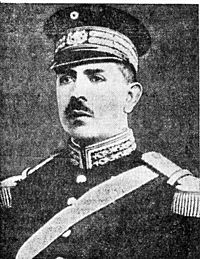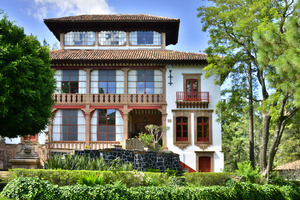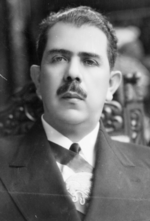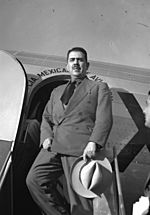Lázaro Cárdenas facts for kids
Quick facts for kids Lázaro Cárdenas |
|
|---|---|

Cárdenas in 1934
|
|
| 51st President of Mexico | |
| In office 1 December 1934 – 30 November 1940 |
|
| Preceded by | Abelardo L. Rodríguez |
| Succeeded by | Manuel Ávila Camacho |
| Secretary of National Defence | |
| In office 1 September 1942 – 31 August 1945 |
|
| President | Manuel Ávila Camacho |
| Preceded by | Jesús Agustín Castro |
| Succeeded by | Francisco Luis Urquizo |
| Governor of Michoacán | |
| In office 1928–1932 |
|
| Preceded by | Luis Méndez |
| Succeeded by | Dámaso Cárdenas |
| President of the Institutional Revolutionary Party | |
| In office 16 October 1930 – 27 August 1931 |
|
| Preceded by | Emilio Portes Gil |
| Succeeded by | Manuel Pérez Treviño |
| Personal details | |
| Born | Lázaro Cárdenas del Río 21 May 1895 Jiquilpan, Michoacán, Mexico |
| Died | 19 October 1970 (aged 75) Mexico City, Mexico |
| Resting place | Monument to the Revolution Mexico City, Mexico |
| Nationality | Mexican |
| Political party | Institutional Revolutionary Party |
| Spouse(s) |
Amalia Solórzano
(m. 1932) |
| Children | Cuauhtémoc Cárdenas |
| Occupation | Statesman, General |
| Military service | |
| Service/branch | Mexican Army |
| Years of service | 1913–1928 |
| Rank | General |
| Commands | Mexican Revolution |
Lázaro Cárdenas del Río (born May 21, 1895 – died October 19, 1970) was a Mexican army officer and politician. He served as the president of Mexico from 1934 to 1940. He is remembered for making big changes in Mexico.
Cárdenas was born in Jiquilpan, Michoacán. His family was working-class. He joined the Mexican Revolution and became a general. Even though he wasn't from the powerful state of Sonora, he was chosen by former president Plutarco Elías Calles to run for president. Cárdenas won the election easily.
Calles had been the real power behind the scenes for years. He expected to control Cárdenas too. But Cárdenas was smart and forced Calles to leave the country. Cárdenas then changed the ruling party, making it stronger. He included groups like farmers, workers, and even the army in the party. This helped make the army less involved in politics.
Cárdenas was a left-leaning leader who believed Mexico should control its own economy. In 1938, he took over the foreign-owned oil companies in Mexico. He created a state-owned oil company called Pemex. He also gave huge amounts of land to poor farmers. These lands were called ejidos. He also started important schools like the National Polytechnic Institute. Cárdenas helped people fleeing the Spanish Civil War. He was the first president to serve a full six-year term, called a sexenio. Many people consider him the most popular Mexican president of the 20th century.
Contents
- Early Life and Military Career
- Governor of Michoacán
- Road to the Presidency
- Cárdenas as President (1934–1940)
- His Relationship with the Military
- Church and State
- Land Reform for Farmers
- Supporting Workers
- Education for All
- Helping Indigenous Peoples
- Women's Right to Vote
- Reorganizing the Ruling Party
- Taking Control of Oil
- Helping Spanish Refugees
- Other Important Actions
- Dealing with Challenges
- Choosing a Successor
- After the Presidency
- Honors and Legacy
- Images for kids
Early Life and Military Career
Lázaro Cárdenas del Río was born on May 21, 1895. He was one of eight children in a family that wasn't rich. His father owned a billiard hall in their village of Jiquilpan. When his father died, Cárdenas was only 16. He had to support his mother and seven younger brothers and sisters.
By age 18, he had worked many jobs. He was a tax collector, a printer's helper, and even a jail keeper. He left school at eleven. But he loved to learn and read many books, especially history.
Joining the Revolution
Cárdenas wanted to be a teacher. But the Mexican Revolution changed his path. In 1913, President Francisco I. Madero was overthrown. Cárdenas joined a group of revolutionaries. He quickly showed his skills and honesty. He became a captain and was in charge of money.
He joined the Constitutionalist army, which eventually won the Revolution. He served under important leaders like Álvaro Obregón and Plutarco Elías Calles. Cárdenas became a general at just 25 years old.
Working with Calles
Cárdenas was a close follower of General Calles. But he also learned from another general, Francisco José Múgica. Múgica believed in socialism, which meant the government should help solve Mexico's problems. Cárdenas saw foreign oil companies in Mexico. They often avoided taxes and treated the land like their own. This experience helped shape his views later on.
Governor of Michoacán
In 1928, Cárdenas became governor of his home state, Michoacán. At this time, there was a big conflict between the government and the Catholic Church. This was known as the Cristero War. Cárdenas worked to bring peace.
He also started important changes. He helped farmers and workers form groups. He called this the Confederación Revolucionaria Michoacana del Trabajo. This group helped him get support from many people. He used this model later when he became president.
Land for Farmers
As governor, Cárdenas focused on giving land to poor farmers. He took large estates from rich landowners. He turned these into ejidos. These were lands owned by the community but controlled by the government. Farmers worked individual plots but did not own them privately. This program helped many poor families.
He also worked to improve schools. He made sure teachers were paid on time. He visited schools himself and opened many new ones in rural areas. Cárdenas liked to talk directly to people to understand their needs.
Promoting Culture and Peace
Cárdenas wanted to bring peace to Michoacán. He also wanted to make places like Pátzcuaro popular for tourists. He built a house there called "La Quinta Eréndira." It was named after a local princess who fought against the Spanish. This showed his respect for Mexico's indigenous history.
Road to the Presidency
In 1934, Calles chose Cárdenas to be the presidential candidate for the ruling party, the PNR. Cárdenas was seen as honest and smart. He had proven himself in the military and in politics. Everyone expected him to be loyal to Calles, who was still the most powerful man in Mexico.
Winning the election was almost certain for Cárdenas. He won with over 98 percent of the votes. Calles thought he could control Cárdenas, just like he had controlled other presidents. But Cárdenas had other plans.
The Six-Year Plan
Cárdenas ran his campaign based on the "Six-Year Plan." This plan was created by the party and Calles. It aimed to make big social and political changes. The plan called for:
- Breaking up large land estates and creating community-owned ejidos.
- Modern, non-religious schools and reducing the influence of the Catholic Church.
- Helping workers form groups to fight unfair business practices.
Cárdenas traveled all over Mexico during his campaign. He met people in many rural areas who had never seen a presidential candidate before. This helped him build his own support base. He promised land reform to farmers and better schools for indigenous people. He acted like a president already, solving problems between groups.
Cárdenas as President (1934–1940)
When Cárdenas became president, he immediately cut his own salary in half. He moved the official presidential home to Los Pinos. He turned the old, fancy presidential palace into a national museum. He also closed down gambling casinos, which hurt the rich friends of Calles. Cárdenas was brave and didn't use armored cars or bodyguards. He often traveled with just a driver and an assistant.
His Relationship with the Military
As a former general, Cárdenas knew the military well. He wanted to make sure the army was under the control of the civilian government. He didn't want generals to try to take power. He gained the loyalty of younger officers by giving them better housing and schooling for their children. He also armed farmers to balance the power of the army.
Church and State
Cárdenas improved relations with the Catholic Church. He ended some strict laws against the Church. He worked with the Mexican Archbishop to encourage peace. However, he still pushed for socialist education in schools. This meant teaching about social equality and less about religion.
Land Reform for Farmers
Cárdenas's presidency saw huge changes in land ownership. He gave about 180,000 square kilometers of land to farmers. This land came from large private estates. He created many new ejidos, which were community-owned lands. This helped many poor families get land to farm.
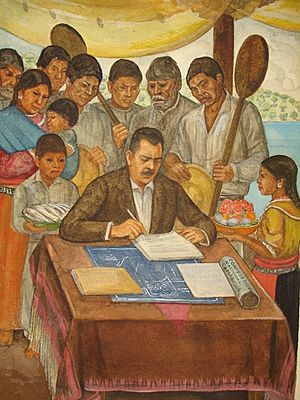
He also created the National Peasant Confederation (CNC). This group helped organize farmers and gave them a voice in the government. Cárdenas believed that organized farmers would be a strong force. They could stand up to rich landowners and support the new Mexican government.
Supporting Workers
Cárdenas also strongly supported industrial workers. He helped create the Confederation of Mexican Workers (CTM). This union became very powerful. It worked with Cárdenas to improve workers' rights. The CTM supported Cárdenas when he forced Calles into exile.
Cárdenas also took over the railway system in 1937. He put it under the control of the workers.
Education for All
Cárdenas believed in education for everyone. He wanted to reduce the Church's influence in schools. He also founded the National Polytechnic Institute (IPN) in Mexico City. This technical university was created to train engineers and scientists. This was very important, especially after he took over the oil industry.
Helping Indigenous Peoples
Cárdenas created a new government department in 1936. It was called the Department of Indigenous Affairs. Its goal was to help Mexico's indigenous people. It worked to improve their economic and social conditions. The department also defended indigenous communities from unfair treatment.
The department held national meetings for different indigenous groups. This allowed them to discuss their common issues. The government wanted to help indigenous people become equal members of the country.
Women's Right to Vote
Cárdenas strongly supported women's right to vote. He believed in equality for all citizens. Many women activists pushed for this change. The law to allow women to vote passed in Congress. However, it was not fully put into practice at that time. Some people worried that Catholic women would vote as priests told them. Women in Mexico finally got the right to vote in 1953.
Reorganizing the Ruling Party
In 1938, Cárdenas changed the ruling party. He dissolved the old PNR and created the Party of the Mexican Revolution (PRM). This new party was organized into four main groups:
- Industrial workers
- Farmers
- Middle-class people (like government workers)
- The military
This new structure gave different groups a formal voice in the government. It also helped Cárdenas control the military. He said, "We did not put the Army in politics. It was already there. In fact it had been dominating the situation, and we did well to reduce its voice to one in four." This system helped keep peace and stability in Mexico for many years.
Taking Control of Oil
One of Cárdenas's most famous actions was taking over the oil industry. Foreign companies owned most of Mexico's oil. They often paid low wages and avoided taxes. In 1938, Mexican oil workers demanded better pay. The companies refused.
Cárdenas supported the workers. On March 18, 1938, he announced that Mexico was taking control of its oil. He nationalized all foreign oil companies. This meant the oil and equipment now belonged to Mexico. This news made many Mexicans very proud. People even donated money to help pay the companies back.
Other countries, especially the United Kingdom, were very angry. They stopped buying Mexican oil. But Mexico eventually got the oil fields working again. Cárdenas created the state-owned oil company, Pemex. Pemex became a model for other countries wanting to control their own resources.
Helping Spanish Refugees
Cárdenas supported the Republican government in Spain during the Spanish Civil War. He sent aid and offered a safe place for Spanish refugees. Thousands of Spaniards came to Mexico. Many of them were smart thinkers and artists. They helped enrich Mexican culture and education. For example, the Colegio de México, a top university, was founded with Cárdenas's support to help these intellectuals.
He also allowed Leon Trotsky, a Russian revolutionary, to live in Mexico. This showed that Cárdenas was not controlled by other powerful countries.
Other Important Actions
Cárdenas also founded the Nacional Financiera, a bank to help develop Mexico's economy. He built many roads and schools. He doubled the money spent on rural education. Cárdenas also ended capital punishment (the death penalty) in Mexico. This helped bring an end to the rebellions that followed the Mexican Revolution.
Dealing with Challenges
In 1938, a general named Saturnino Cedillo led a revolt against Cárdenas. Cedillo was a powerful local leader. But Cárdenas's government was strong. The army crushed the uprising. Cedillo was killed in 1939. This showed that the new Mexican government was firmly in control.
Some right-wing groups also opposed Cárdenas. These included the National Synarchist Union and the National Action Party (PAN). The PAN later became a major opposition party.
Choosing a Successor
In 1940, Cárdenas had to choose the next president. He picked Manuel Ávila Camacho. Ávila Camacho was a moderate, not as left-leaning as Cárdenas. This choice surprised some people. Cárdenas wanted to prevent more conflict and ensure a smooth transfer of power.
The election was difficult, with some violence. But Ávila Camacho won. Cárdenas set an important example. He stepped down from power peacefully. He did not try to control the next president, unlike Calles.
After the Presidency
After his term, Cárdenas continued to serve Mexico. He was Minister of War from 1942 to 1945 during World War II. He then retired to a simple home by Lake Pátzcuaro. He spent the rest of his life helping the poor. He worked on irrigation projects and supported free medical clinics and education.
He also spoke out on world issues. He supported human rights and democracy in Latin America. He opposed the Vietnam War. He also supported Cuba after its revolution in 1959. Cárdenas was concerned when later Mexican presidents moved away from his progressive ideas. He encouraged them to return to the ideals of the Mexican Revolution.
In 1968, Cárdenas was saddened by the government's harsh actions against student protests in Mexico City. He died on October 19, 1970, at age 75. He is buried in the Monument to the Revolution in Mexico City. His son, Cuauhtémoc Cárdenas, and grandson, Lázaro Cárdenas Batel, also became important politicians.
Honors and Legacy
Many places in Mexico are named after Lázaro Cárdenas. These include cities, towns, and a large dam. Streets in Mexico City, Guadalajara, and other cities bear his name. There are also streets and a monument named after him in Spain. This honors his help to Spanish refugees.
In 1955, he received the Stalin Peace Prize. This award was given to people who supported peace and the Soviet Union's ideas.
Cárdenas is remembered for many things. He gave land to farmers and created welfare programs for the poor. He nationalized the oil and railway industries. The party he founded, the PRM, became the PRI. The PRI ruled Mexico for many decades. His son later formed a new party, the Democratic Revolution Party (PRD). This party aimed to bring back some of Cárdenas's original ideals.
Cárdenas is seen as a true revolutionary. He wanted to make his country great, not just himself rich. He is praised for trying to make Mexico a fairer place for everyone.
Images for kids
 In Spanish: Lázaro Cárdenas para niños
In Spanish: Lázaro Cárdenas para niños
- History of Mexico
- List of heads of state of Mexico
- Monument to Lázaro Cárdenas
- Lázaro Cárdenas Park, Puerto Vallarta, Mexico
- Statue of Lázaro Cárdenas (Madrid)


